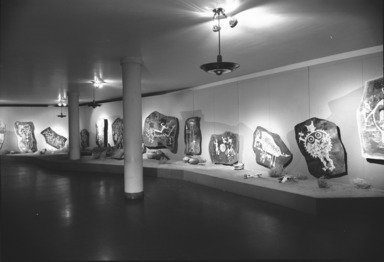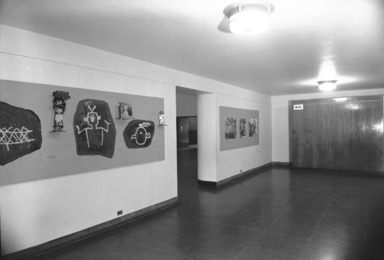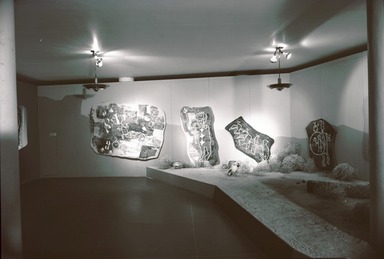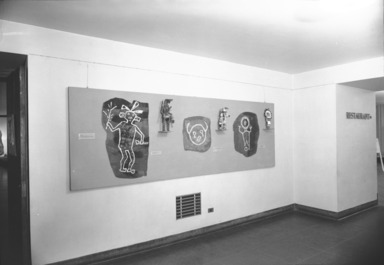

American Indian Rock Drawings, October 09, 1952 through January 04, 1953 (Image: PHO_E1952i017.jpg Brooklyn Museum photograph, 1952)

American Indian Rock Drawings, October 09, 1952 through January 04, 1953 (Image: PHO_E1952i018.jpg Brooklyn Museum photograph, 1952)

American Indian Rock Drawings, October 09, 1952 through January 04, 1953 (Image: PHO_E1952i019.jpg Brooklyn Museum photograph, 1952)
American Indian Rock Drawings
DATES October 09, 1952 through January 04, 1953
ORGANIZING DEPARTMENT
Arts of the Americas
COLLECTIONS
Arts of the Americas
-
September 8, 1952
The Brooklyn Museum is rolling out the velvet carpet this week as it enters into the final preparations for the worldwide museum seminar opening there September 14 under the sponsorship of the United Nations Educational, Scientific and Cultural Organization. This seminar, first of its kind to be held by UNESCO, will continue through October 12.
Everyone connected with the museum -- from curatorial staff to maintenance staff, from art expert to house painter, from superintendent to carpenter, from editor to printer -- is dedicated to polishing and shining the program for the monthlong seminar. This is all part of the greeting the delegates have been promised by Charles Nagel, director of the Brooklyn Museum.
“Every effort is being made to welcome the delegates with all the hospitality at our command,” he said today, “and no effort is being spared to insure their visit being worthwhile.”
AMERICAN SHOWMANSHIP
The elaborate museum plans for the seminar participants, who will be coming from 22 countries to study and discuss “The Role of the Museum in Education,” include three special exhibitions. As a host eyes the appointments of his home on the eve of entertaining, the museum administrators have made certain that the trio of shows, in their conception, typify the lively techniques of cultural showmanship employed by museums in the United States.
Nothing has been forgotten. The exhibitions cut across many paths in the art world and hold interest for all age levels. All three project American art ways, beginning with the art of the American Indian. The installation of the shows has been carefully and skillfully planned, again to demonstrate the American way.
ART OBJECTS FOR THE HOME
When the delegates arrive for the opening of the UNESCO seminar, in progress will be the show “The Artist as Artisan,” which opened yesterday (September 7-September 28) in the main lobby of the museum. The show, a dramatically installed demonstration by the faculty of the Brooklyn Museum Art School, presents work by artists whose technical training has resulted in the decorative ceramics, tapestry, textiles, enamel ware, jewelry and furniture on display.
Played against the museum background, the exhibit will point up to the foreign delegates the varied uses American artists are encouraged to make of museum collections to project their ideas in the field of applied design.
EXTENSIVE PRINT SHOW
The second show being staged for the UNESCO delegates, and which will run concurrently with “The Artist as Artisan,” is “New Expressions in Fine Print Making.”
Print making has come to have new meaning in the hands of young, imaginative American artists who have turned to such unorthodox tools as the electric drill and the electric sander in order to give expression to their creative and perceptive minds. The show, under the direction of Miss Una E. Johnson, curator of prints and drawings of the Brooklyn Museum, is, in scope, the most extensive print technique exhibition ever staged on the Eastern seaboard.
The print show will have a private opening the evening of September 15 when the trustees of the Brooklyn Institute of Arts and Sciences, Robert E. Blum, president, entertain the UNESCO delegates as a reception and dinner in the Brooklyn Museum.
INDIAN ROCK DRAWINGS
The third show, opening toward the end of the UNESCO seminar, cuts across still another field in art, an ancient one, that of the American Indian.
On October 8, the museum’s Department of Primitive Art, Frederick E. Pleasants, curator, will open an exhibition on “American Indian Rock Drawings.” This show will present the work of Agnes Sims, prominent young Santa Fe artist, who has for some years adapted the art, history and mythology of Indians of the Southwest to a strikingly original style.
Her study of petroglyphs, or rock drawings, forms the basis of the show. The rock drawings, transposed to paper by Miss Sims, will be projected in a number of ways in the museum show.
Done in three sections in the main exhibition gallery, the first part will contain background material on the drawings; the second section will consist of an abstraction of a cliff on one side of the gallery and on the other side the petroglyphs with their modern parallels in the form of sculpture and other art expressions. The exhibition then moves into another phase, a display of the petroglyphs as decorative art for the contemporary home. Actual room settings will suggest their use in the home.
VIEWED AS CONTRIBUTIONS TO DAILY LIFE
Mr. Nagel, who is president of the Association of Art Museum Directors, expressed the opinion that American museums no longer expect the public “to come to us simply because we exist.
“Progressive American museums have blazed a trail away from exhibition without interpretation, towards active use and a contribution to present-day living.
“It is this dynamic approach to becoming part of the contemporary scene of which we are particularly proud; we hope that it is this approach which led UNESCO to bring the seminar to this country,” he concluded.
Brooklyn Museum Archives. Records of the Department of Public Information. Press releases, 1947 - 1952. 07-09/1952, 078-80.
View Original -
October 9, 1952
The special exhibition hall of the Brooklyn Museum, from Oct. 9 to Jan. 4, will be devoted to a showing entitled “Indian Rock Drawings.”
This exciting and colorful tribute to the art of the American Indian will be presented in three sections: The first part will contain background material on the drawings; the second part, an abstraction of a cliff and petroglyphs with their modern parallels in the form of sculpture and other art expressions; the third, room settings applying the petroglyphs as contemporary decorative art in the home.
The Indian rock drawings or petroglyphs have been faithfully copied and measured by Miss Agnes Sims, young artist of the Southwest, who transposed the drawings from the rocks to paper for this exhibition.
"The richness and variety of art expression in aboriginal North and South America is nowhere more eloquently illustrated than by the Indian petroglyphs and pictographs that are scattered over the country from California to Maine,” states Frederick R. Pleasants, Curator of Primitive Art of the Brooklyn Museum.
“Ranging from realistic representation of the human figure to abstract geometric drawings they provide a cross-section of subject matter and style. The rock drawings have an amazing vitality which makes them of unusual interest to modern artists as well as ethnologists.”
Miss Sims has for some years studied the art, history and mythology of Indians of the Southwest.
Photographs of special pieces in the exhibition may be obtained on request.
A folder of the exhibition will be published.
Brooklyn Museum Archives. Records of the Department of Public Information. Press releases, 1947 - 1952. 10-12/1952, 095.
View Original

